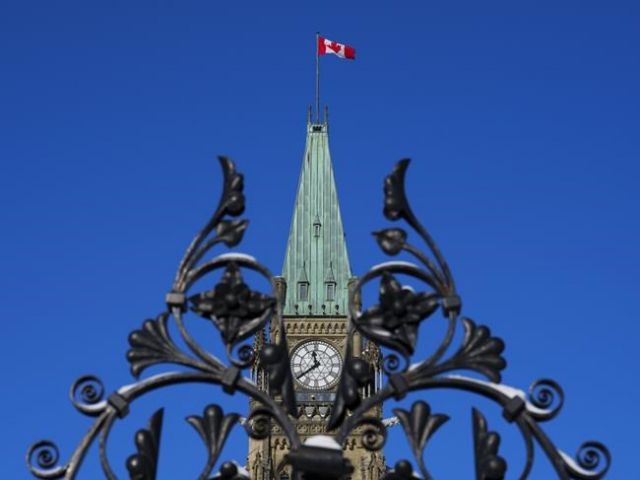
The federal Liberals are set to unveil a budget on Tuesday intended to showcase their plans to keep Canada competitive amid the clean energy transition while supporting Canadians who are struggling with affordability.
Finance Minister Chrystia Freeland has promised to accomplish as much over the last few weeks, while also pledging to keep the budget fiscally restrained.
But that balancing act isn’t expected to be easy. A slowing Canadian economy could weigh on government coffers.
«It’s going to be very tricky for the federal government,» said Randall Bartlett, a senior director of Canadian economics at Desjardins.
The Liberals are expected to invest considerably in Canada’s clean energy transition, in an attempt to keep Canada competitive with the United States as it launches its own aggressive measures.
The Inflation Reduction Act, signed into law last August by U.S. President Joe Biden, invests nearly US$400 billion in everything from critical minerals to battery manufacturing, electric vehicles and clean electricity, including hydrogen.
Ottawa has also promised big bucks for health care. It recently signed 10-year funding agreements with provinces on health-care transfers, and that spending is expected to be accounted for in the budget.
And with the cost of living still a top economic issue for many Canadians, the Liberals have signalled the budget will include new affordability measures.
«In the weeks to come, for those Canadians who feel the bite of rising prices the most acutely, for our most vulnerable friends and neighbours, our government will deliver additional, targeted inflation relief,» Freeland said in Oshawa, Ont. on Monday.
But Bartlett said the federal government has to balance its big-ticket spending priorities with an uncertain economic outlook.
Many economists are forecasting that Canada could enter a recession this year as high interest rates weigh on the economy. Since March 2022, the Bank of Canada has aggressively raised interest rates to crack down on high inflation.
As global price pressures ease and interest rates dampen spending in the economy, inflation has been slowing. Canada’s annual inflation rate has tumbled from 8.1 per cent in the summer to 5.2 per cent in February.
Even as inflation becomes less of a problem, though, a slowing economy means less government revenues to finance spending.
According to a report from Desjardins, new spending measures alone wouldn’t necessarily put federal finances on an unsustainable path. But if significant new spending is paired with a worse-than-expected economic downturn, that could spell trouble for the federal government, the report says.
«Planning for an optimistic future and spending accordingly now could lead to very challenging circumstances going forward,» Bartlett said.
The federal government also runs the risk of fuelling inflation with excessive spending, making the Bank of Canada’s job of cooling inflation more challenging. Freeland has repeatedly said she doesn’t plan on doing that, noting the federal government can’t compensate all Canadians for the rise in prices.
Bartlett said the federal government so far has done a good job balancing the need to help low-income Canadians while avoiding adding fuel to the fire.
«My concern is this that (if) they continue to layer this on top of additional spending for other other initiatives … it’s not only going to make potentially the Bank of Canada’s job more challenging, but it’s also going to just increase the size of the deficit at a time when the economic outlook is very uncertain,» he said.
There is some ambiguity around how the government will approach tax policy in this year’s budget.
Some policy experts have suggested that increasing tax revenues might be part of the solution when it comes to stabilizing federal finances. A shadow budget put together for the C.D. Howe Institute, an economic thinktank, recommended increasing the GST tax rate.
But Bartlett said raising taxes might be a tough sell for Canadians, especially because the federal government has had mixed results on some of its key areas of investment, such as its national housing strategy.
«If we continue to see increased spending, and that requires tax increases to to afford that spending, there’s going to be … increased scrutiny by the public on whether or not we’re getting the bang for the buck,» Bartlett said.
On the political front, the Liberals also have to contend with New Democrat priorities as outlined in the party’s supply-and-confidence agreement with the Liberals. It agreed to support the minority government in key votes until 2025 — including on federal budgets — in exchange for movement on shared priorities.
In the upcoming budget, NDP Leader Jagmeet Singh has said he wants to see the government extend the six-month boost to the GST rebate, introduced last fall, which temporarily doubled the amount people received.
Singh has also said he’d like to see federal funding for school lunches.
Per the parties’ agreement, the Liberals have already agreed to create a federally funded and administered dental care program this year that would replace the dental benefit for children in low-income families that was rolled out in the fall.
The deal also commits the Liberals to passing legislation on a national pharmacare program by the end of 2023 — although there’s been no sign of movement on that yet.